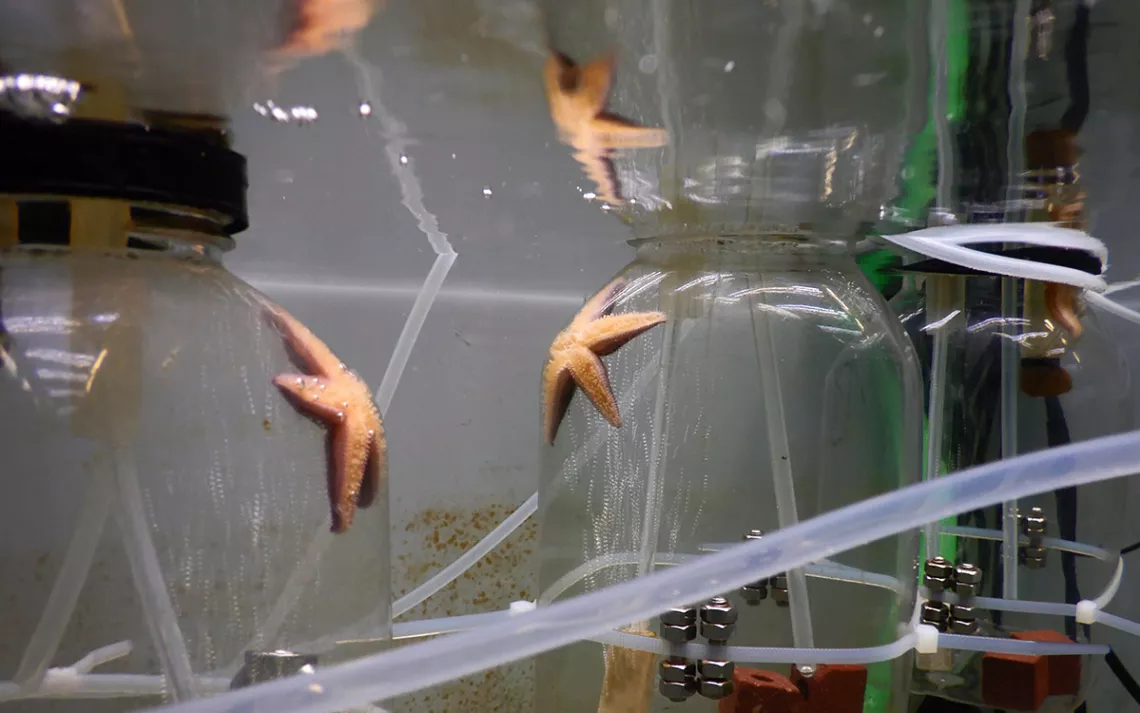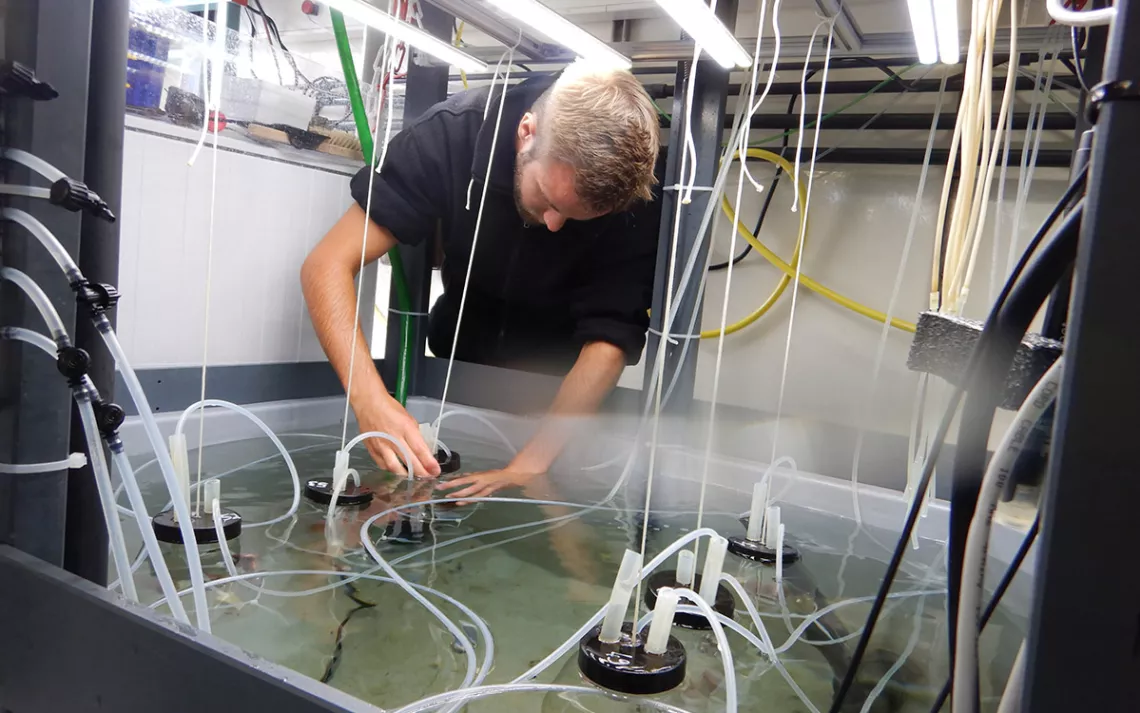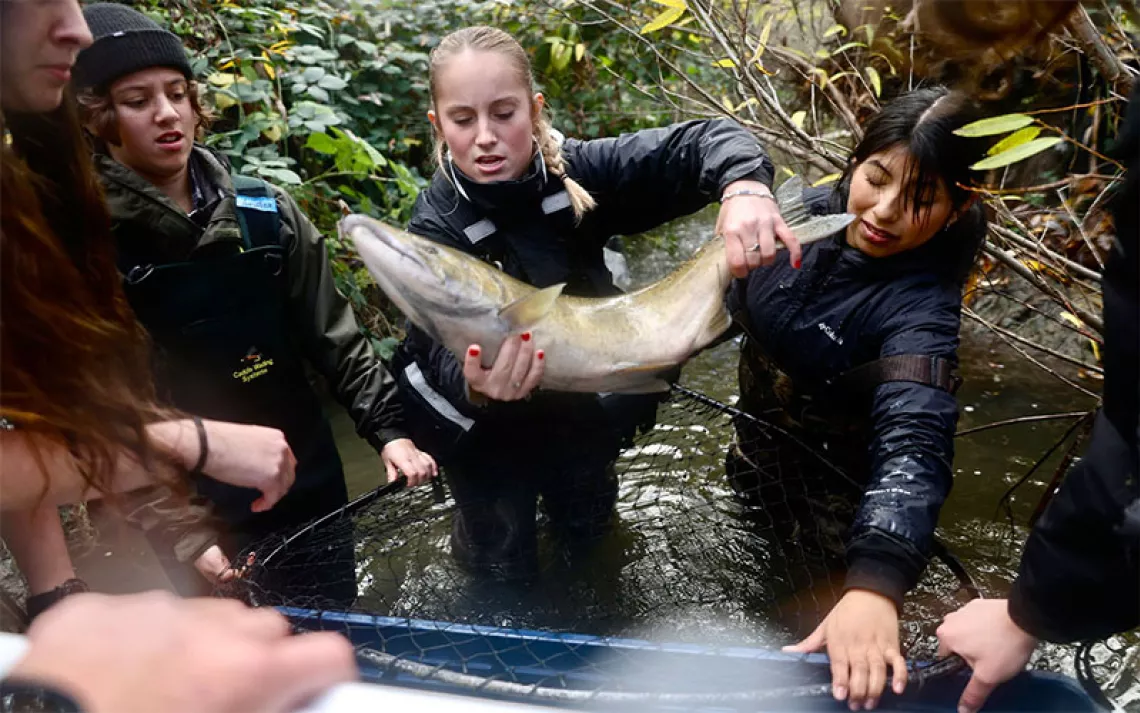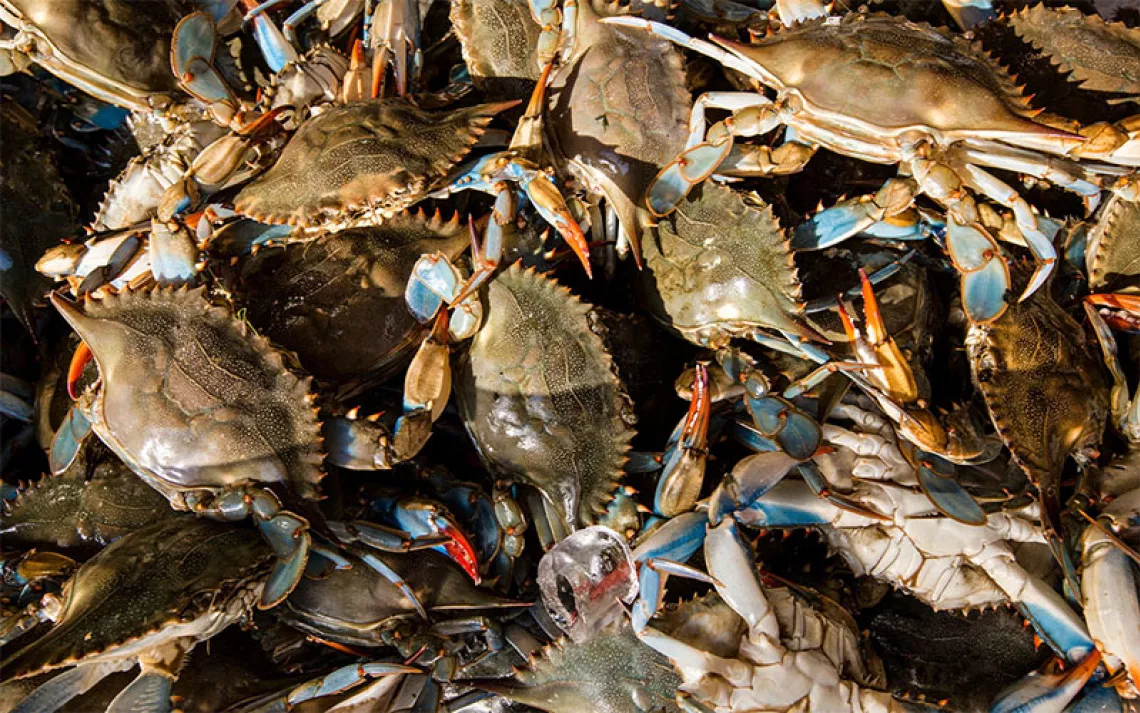Sea Stars Threatened by Intensifying Marine Heat Waves
This keystone predator may build up tolerance to some stressful events, but rising temperatures still pose a risk

Sea stars in a simulated marine heat wave experiment. | Photo by Sarah Rühmkorff
The voracious appetite of the sea star is legendary among ecologists. It is precisely this characteristic that led sea stars to become the prototype of the keystone species: an organism that plays a critical and outsized role in its ecosystem.
Sea stars exert their effects primarily through predation, eating the mollusks that would otherwise outcompete other species and drive down biological diversity. But mounting threats from disease and climate change have put many sea stars at risk, such as the sunflower stars and ochre sea stars along the Pacific coast of North America.
A new study published last month in Proceedings of the Royal Society B examined how sea stars in the Baltic Sea are affected by marine heat waves. Depending on heat wave intensity, the researchers saw impacts ranging from reduced feeding to death. But mild heat waves also seemed to boost the sea stars’ tolerance for other stressors. These findings will help scientists understand how marine species and ecosystems are likely to respond as back-to-back extreme events become more common.
During a marine heat wave, water temperatures stay extremely high for several days, which can have more severe impacts on marine organisms than a shorter spike in temperature would. And with climate change, heat waves globally have been increasing in duration and intensity.
Marine heat waves are a particular concern in the Baltic Sea. “Temperature in general is increasing much faster in the Baltic Sea than it is in many other places worldwide,” says Christian Pansch-Hattich, a marine ecologist at Åbo Akademi University in Finland and a coauthor of the study.
Because of this looming threat, the researchers decided to test how common sea stars from the Baltic Sea respond to marine heat waves. They first collected 60 wild sea stars from the coast near Kiel, Germany, and transferred each individual to a two-liter jar within 10 large tanks in their lab. Tubes pumped seawater into and out of each jar, and heating and cooling units connected to a thermostat carefully controlled the temperature of the surrounding water within each tank.
Now is the time for environmental journalism.
Sign up for your Sierra magazine subscription.

The researchers applied five different heat wave treatments to the sea stars. One group experienced no heat wave. A second group experienced present-day heat wave conditions. And the last three groups experienced projected future heat wave conditions: longer, hotter, or both.
Sea stars experiencing a present-day heat wave, in which water temperatures reached 74.1°F (23.4°C), ate fewer mussels throughout the heat wave treatment. But they made up for it by eating more after the heat wave ended. In the end, they gained just as much weight as the sea stars that stayed in comfortable 65.1°F (18.4°C) water the whole time. In contrast, when the heat wave was extended by a few days, the sea stars ate less and gained less weight over the whole experiment.
“The longer the heat wave was, the more detrimental the effects became,” explains Fabian Wolf, a marine ecologist at the GEOMAR Helmholtz Centre for Ocean Research Kiel and coauthor on the study. The severity of the heat wave had an even larger impact on the sea stars. In the hottest treatments in which the water reached 79.5°F (26.4°C), all of the sea stars died. These treatments simulated the heat wave intensities we can expect to see toward the end of the century.

Fabian Wolf adjusting the jars that house each sea star in the marine heat wave experiment. | Photo by Sarah Rühmkorff
Sarah B. Traiger, a marine ecologist at the USGS Alaska Science Center who was not involved in this study, says that understanding these potentially extreme impacts of heat waves on sea stars is critical because of their well-established role as keystone predators in many coastal ecosystems. “I always think it's really important to look at strongly interacting species like sea stars that have big effects on the rest of the community,” says Traiger.
Along the coasts of the Baltic Sea, for example, sea stars feed extensively on blue mussels. “They can really control the mussel population in the area, which can be intense,” says Pansch-Hattich. If increasingly severe heat waves wiped out the sea stars in this region, mussel densities could skyrocket, crowding out other species and altering the coastal habitat. In addition to testing the effects of simulated heat waves on the sea stars, the researchers also added a second stressor: an upwelling event. During an upwelling, water from deep down rises up precipitously, changing the environmental conditions for organisms near the surface. Along the coasts of the Baltic Sea, this process makes the water more acidic and lowers oxygen levels, which is highly stressful for sea stars and other marine animals.
The researchers wanted to see how sea stars would respond to the double-punch of a heat wave followed immediately by an upwelling, a common scenario in marine systems. To test this, they had to pump water from deep under the surface of the Baltic Sea and add it to the sea stars’ experimental enclosures.
During the simulated upwelling events, the sea stars decreased their activity and feeding rates. But surprisingly, the sea stars that had just experienced a heat wave were less negatively impacted by the upwelling than those that had not. The researchers concluded that heat waves somehow increase the sea stars’ tolerance to other stressors as well, a phenomenon known as cross-stress tolerance.
While they are not sure what enables this tolerance, they suspect it might involve the production of a specialized class of proteins known as heat shock proteins. “Although they're called heat shock proteins, they are involved in many different stress responses,” explains Wolf.
More research is needed to clarify exactly if and how these proteins are involved in the sea stars’ increased tolerance of upwellings following a heat wave. But regardless of the mechanism, this study’s results highlight the complexity in how organisms respond to consecutive stressors.
“These back-to-back events, they're happening more and more frequently everywhere,” says Katie Smith, a marine ecologist at the Marine Biological Association of the UK who was not involved in this study. Experiments like this one, Smith says, “start to help us build this picture of how the multiple events rather than the individual events are impacting species.”
Wolf and Pansch-Hattich are both eager to continue studying how marine organisms respond to a sequence of stressful events, and whether building up tolerance across different types of stressors is a widespread phenomenon. “For the marine areas, we are only starting to investigate this kind of ecological memory,” says Wolf.
Smith also argues that it is critical to improve our understanding of marine heat waves in general. “Every single heat wave has different characteristics,” says Smith. “They're getting longer, they're getting more frequent, they're getting more intense, but there's no real pattern to where or why or how.”
Improving predictions for heat waves could help inform conservation decisions such as where to create new marine protected areas. As Smith explains, “once we can start to predict heat waves better, we can start to develop some resilience in how we manage marine areas or fisheries.”
 The Magazine of The Sierra Club
The Magazine of The Sierra Club



